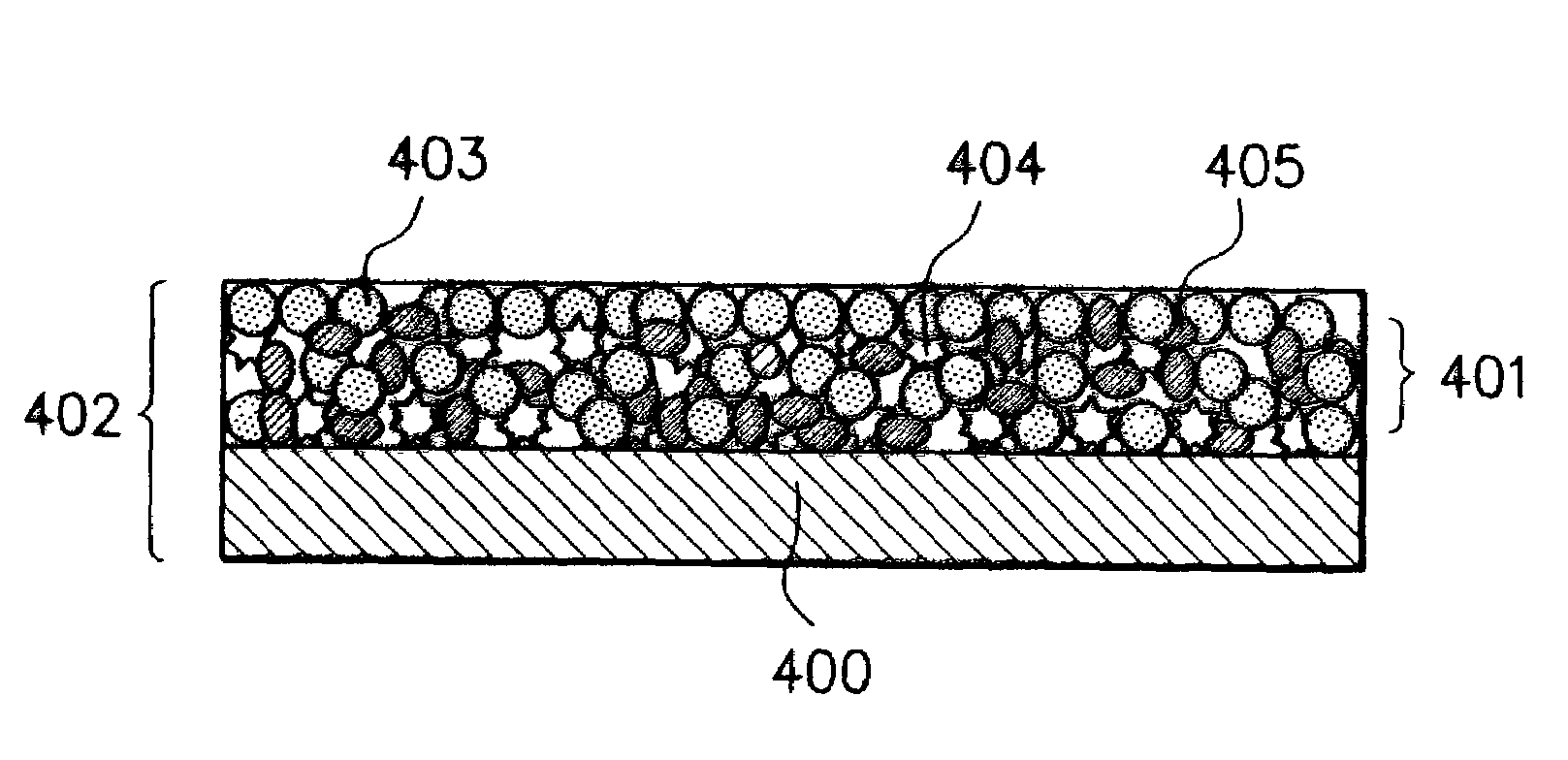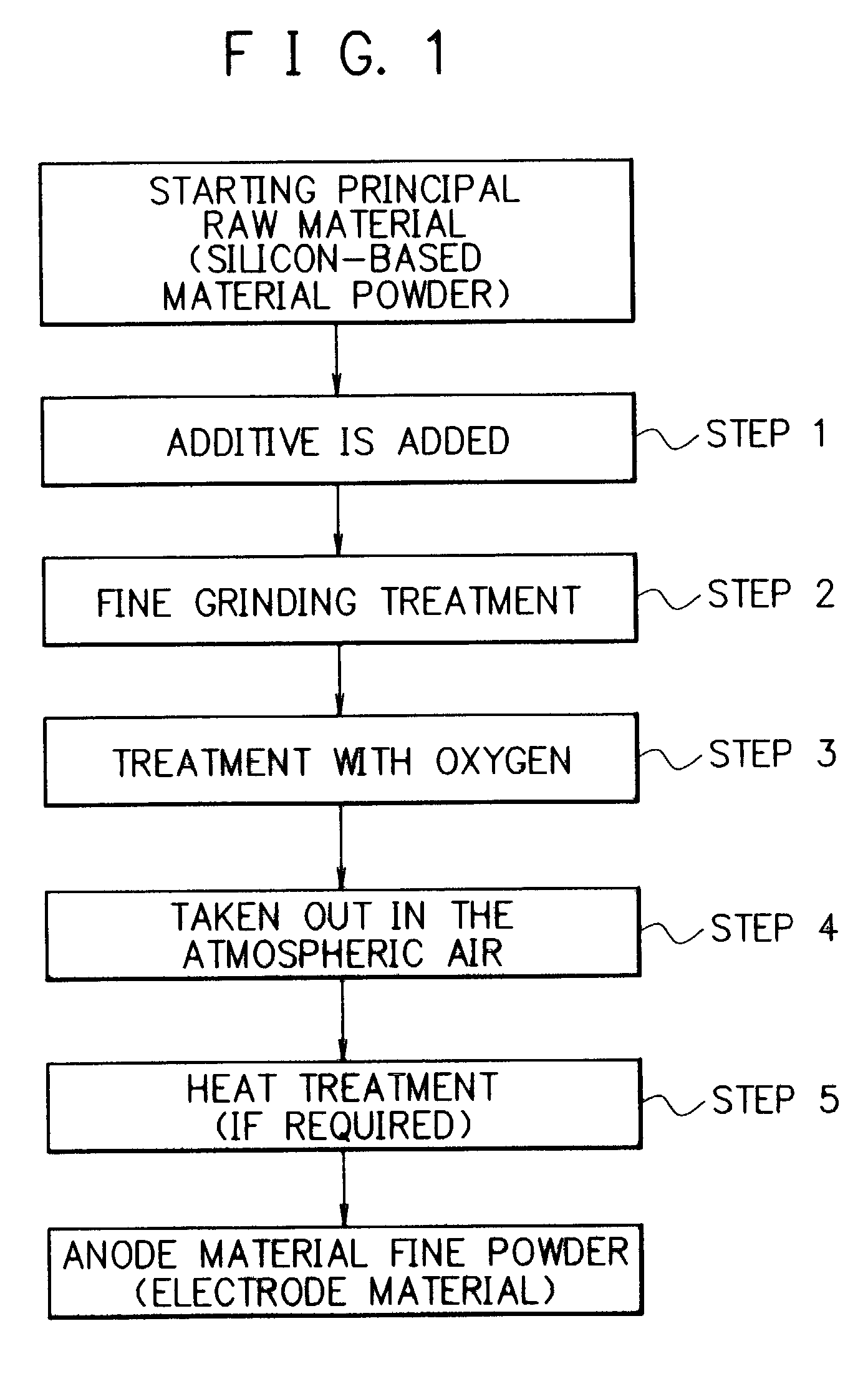Electrode material for rechargeable lithium battery, electrode structural body comprising said electrode material, rechargeable lithium battery having said electrode structural body, process for the production of said electrode structural body, and process for the production of said rechargeable lithium battery
a rechargeable lithium battery and electrode structure technology, applied in the direction of conductive materials, electrode manufacturing processes, final product manufacturing, etc., can solve the problems of difficult lithium ion battery, short circuit between anodes and cathodes, unavoidable problems, etc., and achieve high energy density and high electricity storage capacity.
- Summary
- Abstract
- Description
- Claims
- Application Information
AI Technical Summary
Benefits of technology
Problems solved by technology
Method used
Image
Examples
example 1
[0246]There was prepared an anode material. Particularly, a silicon ingot was pulverized to obtain a course grained silicon powder. The course-grained silicon powder was subjected to a grinding treatment several times to obtain a silicon powder (with a purity of 99.6%) having an average particle size of 10 μm. This silicon powder and a graphite powder having an average particle size of 5 μm were mixed at a mixing weight ratio of 90:10 to obtain a mixture. The mixture was introduced into a media agitating mill, where it was subjected to a fine grinding treatment in a nitrogen gas atmosphere for 3 hours. A finely grained powder afforded in the mill was cooled to room temperature and it was taken out from the mill into the atmospheric air without being subjected to a treatment of forming an oxidation preventive surface coat film. Thus, there was obtain a silicon fine powder as an anode material fine powder.
[0247]The above procedures were repeated five times except for changing the grin...
example 2
[0263]The method for the preparation of an anode material fine powder in Example 1 was repeated, except that the powdery graphite was not used, and the fine grinding treatment in the agitating mill was conducted in a nitrogen gas atmosphere and under condition of affording a finely grained powder having a desired average particle size, and the atmosphere in the agitating mill was substituted by an oxygen-containing nitrogen gas having a prescribed oxygen content where the silicon fine powder afforded by the fine grinding treatment was agitated to react with the oxygen to form a thin oxide surface coat film on the surface of the silicon fine powder. The silicon fine powder whose surface is covered by said thin oxide surface coat film obtained was found to have an average particle size of less than 0.5 μm. After this, the silicon fine powder was taken out from the agitating mill in the atmospheric air, where the silicon fine powder was subjected to a heat treatment at a temperature 35...
example 3
[0273]In accordance with the method for the preparation of an anode material fine powder in Example 1, there was prepared an anode material fine powder having an average particle size of 0.28 μm.
[0274]Using this anode material fine powder and in accordance with the method for the preparation of an electrode structural body in Example 1 except that the addition amount of the powdery graphite as the electrically conductive auxiliary was changed to fall in a range of from 10 wt. % to 76 wt. % (which is a weight proportion of the electrically conductive auxiliary versus the total weight amount of the anode material fine powder (the silicon-based material fine powder, powdery graphite, polyvinyl alcohol and carboxymethyl cellulose which are used in the preparation of the electrode structural body; see, Table 4), there were prepared two electrode structural bodies which are substantially the same with respect to the weight proportion of the electrically conductive auxiliary (Sample 1 and ...
PUM
| Property | Measurement | Unit |
|---|---|---|
| particle size | aaaaa | aaaaa |
| particle size | aaaaa | aaaaa |
| particle size | aaaaa | aaaaa |
Abstract
Description
Claims
Application Information
 Login to View More
Login to View More - R&D
- Intellectual Property
- Life Sciences
- Materials
- Tech Scout
- Unparalleled Data Quality
- Higher Quality Content
- 60% Fewer Hallucinations
Browse by: Latest US Patents, China's latest patents, Technical Efficacy Thesaurus, Application Domain, Technology Topic, Popular Technical Reports.
© 2025 PatSnap. All rights reserved.Legal|Privacy policy|Modern Slavery Act Transparency Statement|Sitemap|About US| Contact US: help@patsnap.com



